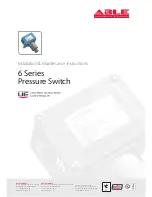
Publication date: Nov, 2014
Revision A1.1
26
A
TROUBLESHOOTING
Basic
Troubleshooting
Tips
Most problems are caused by the following situations.
Check for these items first when starting your
troubleshooting:
Connecting to devices that have a fixed full-
duplex configuration.
The RJ-45 ports are configured as “Auto”, that is, when
connecting to the attached devices, the switch will
operate in one of two ways to determine the link speed
and the communication mode (half duplex or full
duplex):
◆
If the connected device is also configured to Auto,
the switch will automatically negotiate both link
speed and communication mode.
◆
If the connected device has a fixed configuration, for
example 100Mbps, at half or full duplex, the switch
will automatically sense the link speed, but will
default to a communication mode of half duplex.
Because the Series SM24TAT4XA Switch devices
behave in this way (in compliance with the IEEE802.3
standard), if a device connected to the switch has a
fixed configuration at full duplex, the device will not
connect correctly to the switch. The result will be high
error rates and very inefficient communications
between the switch and the device.
Make sure all devices connected to the Series
SM24TAT4XA Switch devices are configured to auto
negotiate, or are configured to connect at half duplex
(all hubs are configured this way, for example).
Faulty or loose cables.
Look for loose or obviously
faulty connections. If they appear to be OK, make sure
the connections are snug. If that does not correct the
problem, try a different cable.
Non-standard cables.
Non-standard and mis-wired
cables may cause network collisions and other network
problems, and can seriously impair network
performance. Use a new correctly-wired cable. For
pinouts and correct cable wiring. A category 5 cable
tester is a recommended tool for every 100Base-TX
and 1000Base-T network installation.
Improper Network Topologies.
It is important to
make sure you have a valid network topology. If you no
longer experience the problems, the new topology is
probably at fault. In addition, you should make sure
that your network topology contains
no data path
loops.













































